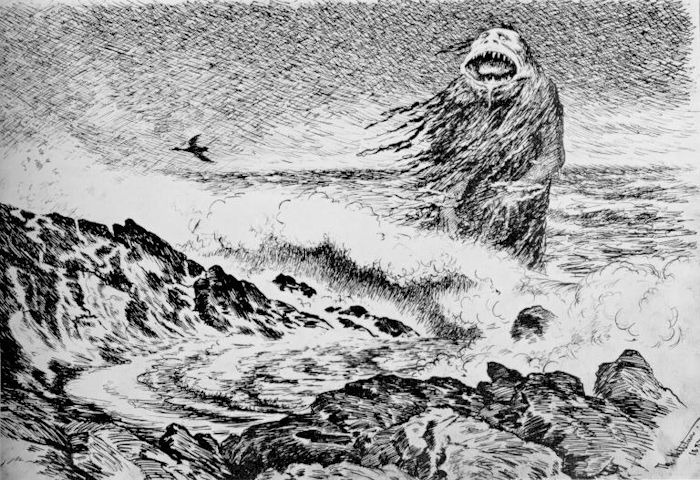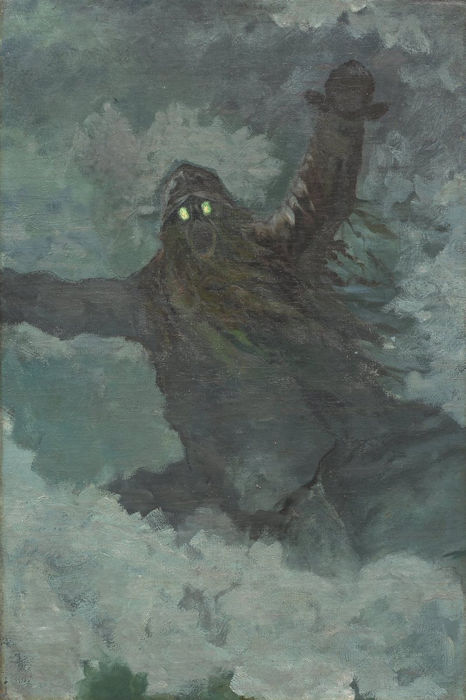Chilling Story Of Glamr Who Became A Draugr, A Living Dead – Scary Yule Haunting
Ellen Lloyd - AncientPages.com - Do you have the courage to challenge supernatural forces? If you decide to do so, remember it will be your own doing.
One man named Glamr was overconfident. Considering himself invincible and untouchable, he thought he could do whatever pleased him and get away with it, but it was a mistake. Fate caught up with him, and his ending was not pretty.
Credit: Adobe Stock - Dave
The story of Glamr, a Swedish herdsman, is one of the scariest Old Norse Yule hauntings we can come across.
Supernatural Creatures In Old Norse Literature
People in ancient Scandinavia were superstitious. They feared and respected supernatural powers, even long after converting to Christianity.
"The peculiarity of Scandinavian and Icelandic ghosts lies in the fact that they are corporeal – not wraiths, disembodied spirits, but the incorporate spirits of the dead. They are animated corpses, solid bodies, generally mischievous and greatly to be feared. Even Iceland, though a new colony, is ghost ridden. In stories relating to Scandinavia, the ghosts are generally men, and this is probably an original feature." 1
"In stories relating to Norway, the ghosts are rarely found far from their burial places, the haugar (sing. huagr), "barrows", containing a stone-built burial chamber roofed with wood, and covered with a great mound of earth. In Iceland, however, a ghost knows no territorial rights and limitations, and is free to wander where he will, either before or after burial." 1
Draugr Was A Living Dead Feared By Many
There is no lack of supernatural elements in Old-Norse literature, and some stories can be truly horrifying.
Supernatural creatures are regarded as dangerous enemies, but some accounts describe people who possess supernatural powers.
In Elder Edda, the word dolgr is restricted to its primary sense of "enemy." "In prose the word as applied to supernatural creatures but only those with which mankind had to contend, such as devils (svartir dolgar), trolls, dragons, giants and phantoms (draugar). But the rod dolgr could also be applied to human beings who exhibited supernatural qualities, such as Grettir." 2
Draugr was one of the creatures most feared by Vikings and ancient people in Scandinavia. The draugr was like a corporeal ghost in Norse mythology. "The creature was a fearsome, ugly living dead who would rise from the grave and make life miserable for people.
Draugr was one of the most feared creatures in ancient Scandinavia. Credit: Theodor Kittelsen (1887) - Public Domain
There is archaeological evidence that Vikings feared the draugr so much that they took the necessary precautions to prevent the draugr from returning to the world of the living." 3
The Curse And Haunting Of Glamr – Was He Killed By Evil Spirits?
This brings us to the cursed Glamr from Sylgsdalr, who figures in Grettis Saga. The man came to a farm in Iceland to work as a hireling.
Grettis Saga (c. 1320) relates the adventures of Grettir, an outlaw hero who, on his return to Iceland, saves the people from the malicious ghost of Glamr the shepherd, who is ravaging the countryside.
Glamr (sometimes referred to as Glam) worked for a wealthy farmer named Thorhall, who had problems acquiring a shepherd because his farm was haunted. However, this was no obstacle to Glamr, who said he was not afraid of ghosts.
On Christmas Eve, Glamr did something that surprised the farmer's wife. The Swedish herdsman ignored Christmas traditions. As he was preparing to go out shepherding, he asked the farmer's wife if he could get some food, but she told him this was a day when they usually fast.
"Now time past there until when comes the eve of Yule. Then Glámr stood up and called for his food. The lady of the house answered: 'It is not proper that Christian men eat meat on this day, because tomorrow is the first day of Yule," she says, "and thus they shall first fast today.'"
Glamr did not want to listen to this. Glamr declared he would eat, criticizing the Yule tradition and scoring locals' superstitions.
"He answers, 'You have many restrictions, when I see no good come of it. I do not know that men fare better now than when they did not heed such things. It seems to me that the customs of men were better when they were called heathens, and now I want my meat, and no foolishness."
Having eaten, Glamr went out and never returned from his work. While everyone was at the Church, a severe storm came over. It was like a bad omen.
The next day people searched for Glamr, but he was nowhere to be found. After days of searching, when his body was discovered, it was described as "dead and blue as Hel and swollen up like an ox."
What caused Glamr's death is unknown, but he did not die of natural causes.
People made several attempts to move his body to the Church to be buried, but it was impossible, and eventually, they had to give up and put him to rest at the spot where had died.
People became convinced an evil spirit must have killed Glamr.
According to the Saga, this is when the horror and Yuletide hauntings started.
"A little time after men were aware that Glámr did not lay quiet. People become so greatly disturbed by this, that many fell into hysteria when they saw him, and some lost their wits. Even after Yule men thought they saw him at home on the farm. People became extremely scared. Many men then fled. Next, Glámr took to riding houses at night, so that he nearly broke them." 4
"Grettir famously defeats Glámr, who is frequently associated with the Old Norse-Icelandic draugr, but not until the revenant has cursed Grettir with unceasing fear of the dark, as terrible light from Glámr's eyes haunts Grettir until the end of his days and he becomes nyctophobic forevermore." 4
As Glamr was dying, he cursed Grettir, predicting he would grow afraid of the dark.
As Grettis Saga says, "So the day passed by, and when it was time for bed, Grettir would not undress and lay down on the platform opposite the farmer's bedcloset. He put a fur poncho over himself and he wrapped one edge down under his feet and the other under his head and looked out through the head-hole … when the door opened, Grettir saw the villain stretch in its head and it seemed to him enormously big and amazingly large-featured.
Credit: Adobe Stock - erika8213
Glam moved slowly and straightened up when he got inside the door. He towered high up into the roof, turned towards the hall and laid his arms up on the cross-beam and leaned in over the hall … Grettir lay quiet and did not move. Glam saw that some sort of heap lay on the platform and he made his way in down the hall and took hold of the poncho rather hard.
Grettir pushed against the platform support and it did not move. Glam jerked again much harder and the poncho held firm.
A third time he pulled it with both hands so hard that he pulled Grettir up from the platform. They now ripped the poncho in two between them. Glam looked at the bit he was holding on to and wondered greatly who could be pulling so hard against him. And at that moment Grettir leapt under his arms and took him round the middle and pressed against his back as hard as he could and intended that Glam should bend over backwards, but the villain pushed at Grettir's arms so hard that he was forced to give way by the superior strength … Glam wanted to get outside, but Grettir dug in his heels wherever he could and still Glam managed to drag him out to the entrance … And when Grettir sees that he cannot hold back with his feet, he does two things at once, he leaps as hard as he can into the villain's embrace and kicks back with both feet at a stone partburied in the ground that stood on the threshold.
The villain was not expecting this. He had been struggling to pull Grettir towards himself, and so Glam toppled over backwards and was flung in reverse out against the doorway so that his shoulders caught the lintel and the roof gave way, both the beams and the frozen thatch. Thus he fell face upwards and backwards outside the building with Grettir on top of him
There was bright moonlight outside and gaps in the heavy cloud. Sometimes it clouded over and sometimes it cleared away. At the moment Glam fell, the cloud cleared from the moon and Glam glared up at it and Grettir himself has said that this was the only sight he ever saw that took him aback.
Draugen (1895) by Theodor Kittelsen. Credit: Public Domain
Then he felt so weakened by everything, his weariness and seeing Glam squint at him fiercely, that he was unable to draw his cutlass and lay just about between life and death. And such was the greater power of evil in Glam than in most other revenants that he then spoke as follows: 'You have displayed great zeal, Grettir,' he said, 'in seeking me out, and it will not seem surprising if you don't gain a great deal of good fortune from your encounter with me.
But I can tell you this, that you have now acquired half the strength and development that was intended for you if you had not met me. I cannot now deprive you of the strength that you have already acquired, but I can ensure that you never become any stronger than you are now, and yet even now you are strong enough, as many will find out to their cost.
You have become renowned up to now for your deeds, but from now on you will become guilty of crimes and deeds of violence, and nearly everything you do will lead to your misfortune and failure.
You will be made outlaw and be compelled always to live in the open on your own. I also lay this upon you that these eyes of mine will be always before your sight, and you will find it hard to be alone and this will bring you to your death.'
The story ends with Grettir cutting off Glamr's head, assuring the Draugr can never terrorize people again."
The adventures of outlaw Grettir and the horrifying fate of Glamr are featured in The Saga of Grettir the Strong, which has been translated into English.
Updated on December 4, 2023
Written by - Ellen Lloyd – AncientPages.com
Copyright © AncientPages.com All rights reserved. This material may not be published, broadcast, rewritten or redistributed in whole or part without the express written permission of AncientPages.com
Expand for references- Chadwick, N. K. (1946). Norse Ghosts (A Study in the Draugr and the Haugbúi). Folklore, 57(2), 50–65.
- Sturtevant, A. M. (1927). Some Etymologies Of Certain Old Norse Words Dealing With The Supernatural.Scandinavian Studies and Notes, 9(5), 151–159.
- Ellen Lloyd - Draugr – Vikings Feared This Ugly Living Dead With Prophetic Visions, AncientPages.com
- Richard Fahey - Yuletide Monsters: Christmas Hauntings in Medieval Literature and Modern Popular Culture, University of Notre Dame
- Matt Firth - Monsters and the Monstrous in the Sagas – The Saga of Grettir the Strong, The Postgrad Chronicles
- Anonymous - The Saga of Grettir the Strong
More From Ancient Pages
-
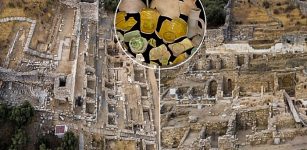 Cisterns Unearthed In Metropolis, Turkey Give Insight Into Daily Life Of Its Inhabitants 1,500 Years Ago
Archaeology | Jan 5, 2021
Cisterns Unearthed In Metropolis, Turkey Give Insight Into Daily Life Of Its Inhabitants 1,500 Years Ago
Archaeology | Jan 5, 2021 -
 New Reading Of Mesha Stele And Consequences For Biblical History
Archaeology | May 2, 2019
New Reading Of Mesha Stele And Consequences For Biblical History
Archaeology | May 2, 2019 -
 Neolithic Boats At La Marmotta Reveal People Used Advanced Nautical Technology 7,000 Years Ago
Archaeology | Mar 22, 2024
Neolithic Boats At La Marmotta Reveal People Used Advanced Nautical Technology 7,000 Years Ago
Archaeology | Mar 22, 2024 -
 Mystery Of The Ancient Giant Wish Stone At Hattusa
Featured Stories | Oct 1, 2019
Mystery Of The Ancient Giant Wish Stone At Hattusa
Featured Stories | Oct 1, 2019 -
 Oil Lamps, Spearheads And Skulls: Was The Te’omim Cave Used By Practitioners Of Necromancy?
Archaeology | Jul 15, 2023
Oil Lamps, Spearheads And Skulls: Was The Te’omim Cave Used By Practitioners Of Necromancy?
Archaeology | Jul 15, 2023 -
 Unique, Well-Preserved 4,000-Year-Old Boat Discovered Near The Ancient City Of Uruk
Archaeology | Apr 4, 2022
Unique, Well-Preserved 4,000-Year-Old Boat Discovered Near The Ancient City Of Uruk
Archaeology | Apr 4, 2022 -
 Yakhchals: Ingenious Ancient ‘Refrigerators’ Could Store Ice In The Hot Desert
Ancient Technology | Sep 15, 2018
Yakhchals: Ingenious Ancient ‘Refrigerators’ Could Store Ice In The Hot Desert
Ancient Technology | Sep 15, 2018 -
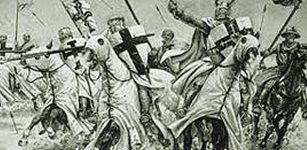 On This Day In History: Battle Of The Rhyndacus – Oct 15, 1211
News | Oct 15, 2015
On This Day In History: Battle Of The Rhyndacus – Oct 15, 1211
News | Oct 15, 2015 -
 Mysterious Unknown Beings Who Walked The Earth With Humans
Featured Stories | Sep 15, 2020
Mysterious Unknown Beings Who Walked The Earth With Humans
Featured Stories | Sep 15, 2020 -
 On This Day In History: Johannes Kepler ‘Father Of Modern Astronomy’ Was Born – On Dec 27, 1571
News | Dec 27, 2016
On This Day In History: Johannes Kepler ‘Father Of Modern Astronomy’ Was Born – On Dec 27, 1571
News | Dec 27, 2016 -
 Treasure Trove Of Spices Found On The Sunken Medieval Ship Gribshunden
Archaeology | Feb 11, 2023
Treasure Trove Of Spices Found On The Sunken Medieval Ship Gribshunden
Archaeology | Feb 11, 2023 -
 Evidence Of An Unknown Neolithic Society At Oued Beht In North Africa Discovered
Archaeology | Sep 30, 2024
Evidence Of An Unknown Neolithic Society At Oued Beht In North Africa Discovered
Archaeology | Sep 30, 2024 -
 On This Day In History: William Of Ockham Secretly Leaves Avignon, Fearing A Death Sentence From Pope – On May 26, 1328
News | May 26, 2016
On This Day In History: William Of Ockham Secretly Leaves Avignon, Fearing A Death Sentence From Pope – On May 26, 1328
News | May 26, 2016 -
 Ponce De Leon’s Quest For The Fountain Of Youth In Florida
Featured Stories | Jun 12, 2019
Ponce De Leon’s Quest For The Fountain Of Youth In Florida
Featured Stories | Jun 12, 2019 -
 Canaanite Temple Dated To 12th Century BC Unearthed At Lachish, Israel
Archaeology | Feb 19, 2020
Canaanite Temple Dated To 12th Century BC Unearthed At Lachish, Israel
Archaeology | Feb 19, 2020 -
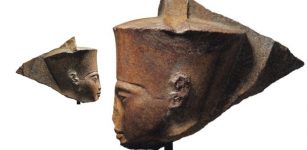 Egypt Calls On Christie’s Auction House In London To Stop Sale Of Tutankhamun Statue Head
Archaeology | Jun 14, 2019
Egypt Calls On Christie’s Auction House In London To Stop Sale Of Tutankhamun Statue Head
Archaeology | Jun 14, 2019 -
 What Were The Strange Objects Biblical Adam Received From Divine Beings?
Biblical Mysteries | Jul 13, 2020
What Were The Strange Objects Biblical Adam Received From Divine Beings?
Biblical Mysteries | Jul 13, 2020 -
 Castlerigg Stone Circle: One Of Britain’s Most Important And Earliest Stone Circles
Featured Stories | Apr 16, 2019
Castlerigg Stone Circle: One Of Britain’s Most Important And Earliest Stone Circles
Featured Stories | Apr 16, 2019 -
 Askeladden – Little Trickster That Succeeds Where All Others Fail
Featured Stories | Mar 23, 2018
Askeladden – Little Trickster That Succeeds Where All Others Fail
Featured Stories | Mar 23, 2018 -
 Our New Relative: ‘Homo Luzonensis’ – New Species Of Early Human Found
Archaeology | Apr 11, 2019
Our New Relative: ‘Homo Luzonensis’ – New Species Of Early Human Found
Archaeology | Apr 11, 2019


